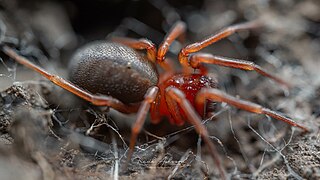
Periegops is a genus of spiders with six eyes instead of the usual eight. It is the only genus in its family (Periegopidae) and has three described species. It was long considered to be a member of Sicariidae or Segestriidae until Raymond Forster elevated it to the family level in 1995.
Zealanapis australis is a spider species in the genus Zealanapis found in New Zealand.
Laetesia chathami is a species of sheet weaver found in New Zealand.
Laetesia aucklandensis is a species of sheet weaver found in the Auckland Islands.

Dolomedes schauinslandi or the Rangatira spider is a large spider of the family Pisauridae. It is only found on South East Island (Rangatira), Houruakopara and Mangere Islands in the Chatham Islands, New Zealand. It is one of New Zealand's largest and rarest spiders.

Forstrarchaea is a monotypic genus of shield spiders from New Zealand containing the single species, Forstrarchaea rubra.

Pararchaea is a monotypic genus of shield spiders from New Zealand containing the single species, Pararchaea alba.

Periegops suterii is a species of spider in the genus Periegops that is endemic to the South Island of New Zealand.

Mamoea grandiosa is a species in the spider family Desidae that is endemic to New Zealand and was first described by Ray Forster and Cecil Wilton in 1973. The holotype specimen was collected by Beverley Holloway at Solomon Island, off Stewart Island, during the 1955 Dominion Museum expedition.
Cantuaria collensis is a species of trapdoor spider endemic to New Zealand.
Cantuaria stewarti is a species of trapdoor spider endemic to New Zealand.
Hexathele exemplar is a species of mygalomorph spider endemic to New Zealand.

Hexathele kohua is a species of mygalomorph spider endemic to New Zealand.

Stanwellia taranga is a species of mygalomorph spider endemic to New Zealand.
Stanwellia tuna is a species of mygalomorph spider endemic to New Zealand.
Tangata stewartensis is a species of Orsolobidae that is endemic to New Zealand.
Maorineta tibialis is a species of sheet weaver spider endemic to New Zealand.
Haplinis rupicola is a species of sheet weaver spider endemic to New Zealand.
Neoramia charybdis is a species of Stiphidiidae that is endemic to New Zealand.
Anoteropsis blesti is a species of Lycosidae that is endemic to New Zealand.







